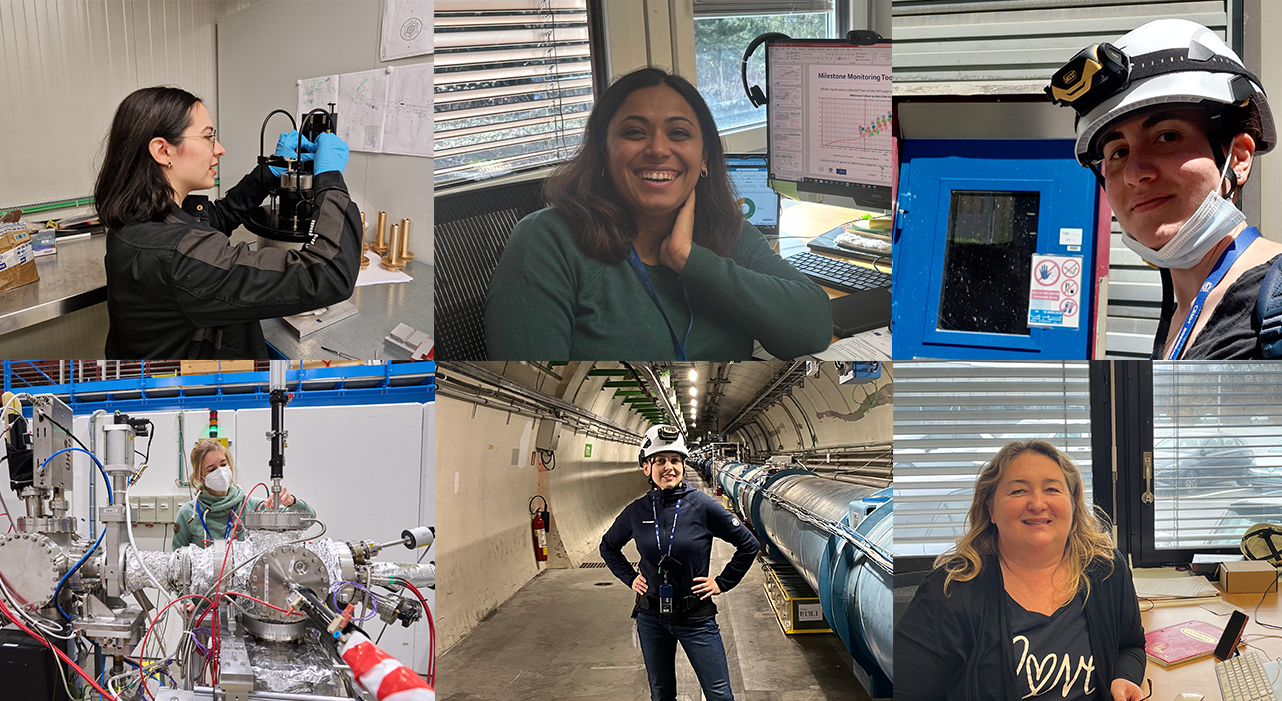
Many women working at CERN pursued studies in STEM (Science, Technology, Engineering, Mathematics) fields to follow their passion to drive positive change, solve complex problems, and make meaningful contributions to science. On the occasion of the 9th International Day of Women and Girls in Science, we take the opportunity to shine a light on a few colleagues that share their open-mindedness and curiosity with us.
Shining a light on mechanical engineer Maud Wehrle, who manages consolidation and renovation projects for two experimental areas in the antimatter factory. Starting out in the beginning of the 2023 year-end technical stop (YETS), her projects concerns the full overhaul of the ALPHA control room involving not only taking down all available services, but also a re-design of the control room and the complete remodelling of the old ATRAP2 area.“I enjoy the combination of project management aspects and advanced technical studies while working on diverse subjects,” explains Maud. Just recently, she took up thermomechanical simulations on beam-intercepting devices for the experimental areas, working closely together with colleagues in the LE and EC sections.
Clara is a PhD student at the PUMA experiment since September 2022. In particular, she works on the entire detection system that reconstructs the process of proton-antiproton annihilation. Anti-protons annihilate with neutrons or protons, releasing a lot of energy, which create in turn other particles. Her work involves simulating and designing detector components as well as the data acquisition system that stores and processes information by the detected particle. Clara appreciates having full overview on all aspects of the experimental set-up rather than focusing on one component, which is not possible in larger experiments.
In the North Area, beam physicist Anna Baratto Roldan helps to provide beams for test-beam users and permanent experiments. Together with the other beam physicists, Anna Baratto Roldan provides beams tailored to the users’ and experiments’ needs in the experimental areas of the H8 beamline. She also works for the Physics Beyond Colliders project, where she performs studies and simulations for future fixed-target experiments at the ECN3 experimental area, but also for ideas on tagged neutrino beams that would be a game changer in measuring the neutrino flux. “I am fascinated by the physics of particle-matter interaction and the wide range of applications that this subject can cover in the field of particle accelerators,” says Anna.
Silvia Schuh works closely with external users, translating their requirements with the help of a new software project to the technical service with the aim to ensure a smooth beam and to achieve the best possible data taking.Finding solutions that suit users can be sometimes challenging, for example when complex detector components need to be installed. “This can sometimes be like a three-dimensional puzzle, equipment needs to fit into the available space of the experimental halls,” says Silvia.
Staying in the North Area, the work of Deepti Kandhol, Eva Kamenicka, and Alicja Ostrega is essential to modernise infrastructure dating back to the 1970s. Project planning officer Deepti monitors and optimises the renovations processes of the North Area Consolidation (NA-CONS) project. Her background in mechanical and management engineering is vital to schedule activities during infrastructure and equipment installation in run periods and shutdowns. “The interaction with different work packages in the project, the different systems and services, help me to further develop my technical competencies that I need to carry out planning and coordination activities,” emphasises Deepti.
During the shutdowns at the beginning and the end of 2023, construction engineer and project cost manager Alicja and her team removed of cables, one of the key achievements during the 2023 YETS period and an important preparation for the upcoming installations. In addition, her role extends to overseeing activities in situ, ensuring their safety and monitoring their progress Alicja never thought of working at so many different aspects of the North Area. "All are diligently working to restart operations in a much-improved situation, as we are in the process of modernizing areas dating back to the 1970s, and it's awe-inspiring to witness the incredible technological advancements we've made since then,” she exclaims.
The consolidation work is not limited to infrastructure of buildings, but also to beam equipment. Eva improves some of the collimators and beam-intercepting devices currently installed in the beamlines,which have not been consolidated for many years. She and a team of technicians and enginneers gradually disassemble spares, replace consumable components and the design to make them more standardized. Afterwards, the new collimators replace the old ones in the beamlines.She also works on other devices, including the movement of a filament scintillator, which reads the profile and position of a beam.
These are just a few examples of a long list of motivated and engaged women in the Experimental Areas group, all seizing every opportunity and to show impressively every day that STEM fields are not only reserved for men. They embrace opportunities to step out of their comfort zones to broaden their horizons and to make new experiences. The BE-EA group enables them to work on a wide range of projects, to use their skills and to excel in their work. Lots of projects and the operation of beam lines in the BE-EA group is only possible thanks to their excellent work and thanks to their remarkable skills.
